Pre-Drying of Chlorine–Organic-Contaminated Soil in a Rotary Dryer for Energy Efficient Thermal Remediation
Abstract
:1. Introduction
2. Materials and Methods
2.1. Experimental Materials
2.2. Experimental System
2.3. Experimental Method
3. Results and Discussion
3.1. Soil Drying Characteristics
3.2. Influence of Rotation Speed on Drying Process
3.3. Influence of Moisture Content on Drying Process
3.4. Desorption of Pollutants in Contaminated Soil during Drying Process
3.5. Volumetric Heat Transfer Coefficient
4. Conclusions
- (1)
- The non-isothermal process of drying organic-polluted soil can be divided into warm-up and falling rate periods, and no constant rate period was observed in soil drying. More than 70% of the moisture evaporation in the soil was concentrated in the warm-up period. The critical point temperature is used for the selection of the drying temperature of a rotary dryer. When the drying requirements and processing efficiency are met, a low critical temperature can be selected to reduce the energy consumption of the system.
- (2)
- A low rotation speed has a greater effect on the drying tail gas temperature and a smaller effect on the outlet soil temperature. In the case of measuring the soil outlet temperature and moisture content, the drying stage of the soil in the dryer can be evaluated using the soil thermogravimetric test results.
- (3)
- A high soil moisture content will increase the humidity of the dry tail gas while lowering the temperature of the dry tail gas and making it easier for the moisture in the dry tail gas to condense and precipitate. In engineering practice, the temperature of the dry tail gas should be increased to above the dew point.
- (4)
- Soil containing benzene and cis-1,2-dichloroethylene is easily desorbed during the drying process. Therefore, in engineering practice, the dry tail gas disposal scheme should be designed according to the type and concentration of soil pollutants to avoid secondary pollution.
- (5)
- When using an indirect rotary dryer to treat organic-contaminated soil, 85–100 W m−3 °C−1 may be considered the reference range for the volumetric heat transfer coefficient.
- (6)
- Shortcomings of this article include a low rotary dryer rotation speed and the fact that the influence of a high rotation speed on the soil drying effect is not explored. The critical rotation speed was not obtained; that is, at this speed, the soil drying requirements can be met, and the processing capacity of the equipment can be maximised.
Author Contributions
Funding
Institutional Review Board Statement
Informed Consent Statement
Data Availability Statement
Conflicts of Interest
References
- Sun, Y.H.; Guan, F.; Yang, W.W.; Wang, F.Y. Removal of chromium from a contaminated soil using oxalic acid, citric acid, and hydrochloric acid: Dynamics, mechanisms, and concomitant removal of non-targeted metals. Int. J. Environ. Res. Public Health 2019, 16, 2771. [Google Scholar] [CrossRef] [PubMed] [Green Version]
- Zhu, X.Z.; Ni, X.; Waigi, M.G.; Liu, J.; Sun, K.; Gao, Y.Z. Biodegradation of mixed PAHs by PAH-Degrading endophytic bacteria. Int. J. Environ. Res. Public Health 2016, 13, 805. [Google Scholar] [CrossRef] [Green Version]
- Khan, F.I.; Husain, T.; Hejazi, R. An overview and analysis of site remediation technologies. J. Environ. Manag. 2004, 71, 95–122. [Google Scholar] [CrossRef] [PubMed]
- Zhao, C.; Dong, Y.; Feng, Y.P.; Li, Y.Z.; Dong, Y. Thermal desorption for remediation of contaminated soil: A review. Chemosphere 2019, 221, 841–855. [Google Scholar] [CrossRef]
- Xia, T.X.; Jiang, L.; Wei, M.; Jia, X.Y.; Zhong, M.S. PAHs thermal desorption behavior of coking plant soil and its effect on soil characteristics. Huagong Xuebao 2014, 65, 1470–1480. [Google Scholar] [CrossRef]
- Liu, J.; Zhang, H.; Yao, Z.T.; Li, X.D.; Tang, J.H. Thermal desorption of PCBs contaminated soil with calcium hydroxide in a rotary kiln. Chemosphere 2019, 220, 1041–1046. [Google Scholar] [CrossRef]
- Bykova, M.V.; Alekseenko, A.V.; Pashkevich, M.A.; Drebenstedt, C. Thermal desorption treatment of petroleum hydrocarbon-contaminated soils of tundra, taiga, and forest steppe landscapes. Environ. Geochem. Health 2021, 43, 2331–2346. [Google Scholar] [CrossRef]
- Ma, F.J.; Zhu, Y.N.; Wu, B.; Zhang, Q.; Xu, D.Y.; Xu, J.W.; Wang, B.; Gu, Q.B.; Li, F.S. Degradation of DDTs in thermal desorption off-gas by pulsed corona discharge plasma. Chemosphere 2019, 233, 913–919. [Google Scholar] [CrossRef]
- Ding, D.; Song, X.; Wei, C.L.; LaChance, J. A review on the sustainability of thermal treatment for contaminated soils. Environ. Pollut. 2019, 253, 449–463. [Google Scholar] [CrossRef]
- Xu, Y.; Gu, H.L.; Zhan, M.X.; Ji, L.J.; Wang, J.Q.; Jiao, W.T.; Chi, Z.H. Energy-saving and consumption-reducing scheme for direct thermal desorption of organic contaminated soil. Chin. J. Environ. Eng. 2019, 13, 2074–2082. [Google Scholar] [CrossRef]
- Troxler, W.L.; Cudahy, J.J.; Zink, R.P.; Yezzi, J.J.; Rosenthal, S.I. Treatment of nonhazardous petroleum-contaminated soils by thermal desorption technologies. J. Air Waste Manag. Assoc. 1993, 43, 1512–1525. [Google Scholar] [CrossRef]
- Mwithiga, G.; Jindal, V.K. Coffee drying in a rotary conduction-type heating unit. J. Food Process Eng. 2004, 27, 143–157. [Google Scholar] [CrossRef]
- Chun, Y.N.; Lim, M.S.; Yoshikawa, K. Development of a high-efficiency rotary dryer for sewage sludge. J. Mater. Cycles Waste Manag. 2012, 14, 65–73. [Google Scholar] [CrossRef]
- Wen, J.M.; Zhang, Z.M.; Wu, J.F.; Shen, J.Y.; Zheng, Z.Y. Experimental study on sewage sludge direct drying in granulating type rotary drum dryer. Zhongguo Jishui Paishui 2012, 28, 101–104. [Google Scholar] [CrossRef]
- Deng, S.; Wen, Z.; Su, F.Y.; Wang, Z.Y.; Lou, G.F.; Liu, X.L.; Dou, R.F. Converter sludge drying in rotating drum using hot steel balls. Appl. Therm. Eng. 2021, 197, 117368. [Google Scholar] [CrossRef]
- Poós, T.; Horváth, M. Municipal waste sludge drying in an agitated drum dryer. Appl. Mech. Mater. 2014, 564, 577–582. [Google Scholar] [CrossRef]
- Hamawand, I.; Pereira da Silva, W.; Eberhard, F.; Antille, D.L. Issues related to waste sewage sludge drying under superheated steam. Pol. J. Chem. Technol. 2015, 17, 5–14. [Google Scholar] [CrossRef] [Green Version]
- Zhang, X.Y.; Chen, M.Q. A comparison of isothermal with nonisothermal drying kinetics of municipal sewage sludge. J. Therm. Anal. Calorim. 2016, 123, 665–673. [Google Scholar] [CrossRef]
- Feng, H.; Tang, J.; John Dixon-Warren, S. Determination of moisture diffusivity of red delicious apple tissues by thermogravimetric analysis. Dry. Technol. 2000, 18, 1183–1199. [Google Scholar] [CrossRef]
- Phanphanich, M.; Mani, S. Impact of torrefaction on the grindability and fuel characteristics of forest biomass. Bioresour. Technol. 2011, 102, 1246–1253. [Google Scholar] [CrossRef]
- Ma, Y.Q.; Fan, X.X.; Liu, Y.F.; Yang, L.G. Effect of moisture content in sludge on thermal-chemistry disposal. Adv. Mater. Res. 2014, 864, 1919–1922. [Google Scholar] [CrossRef]
- Nhuchhen, D.R.; Basu, P.; Acharya, B. Investigation into overall heat transfer coefficient in indirectly heated rotary torrefier. Int. J. Heat Mass Transf. 2016, 102, 64–76. [Google Scholar] [CrossRef]

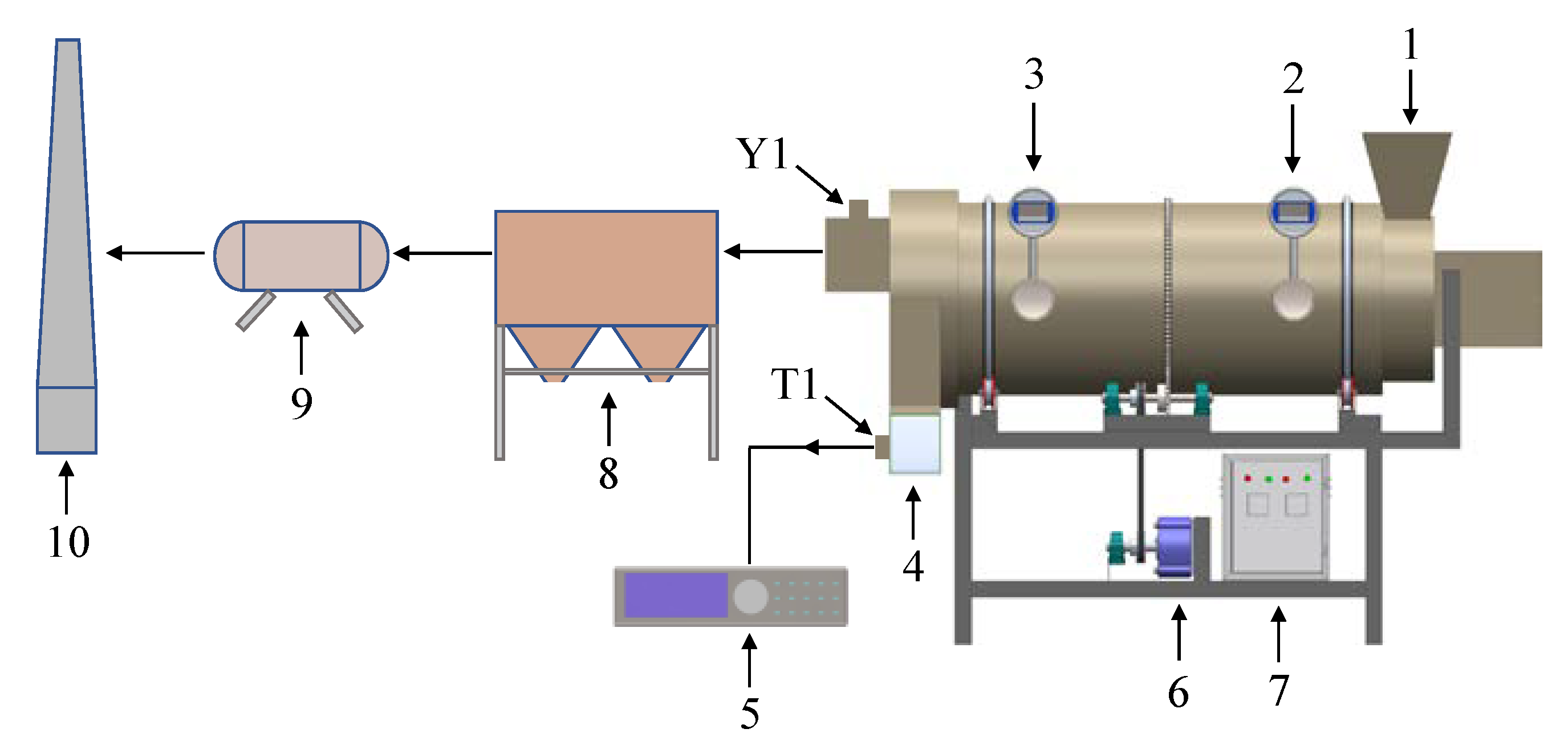
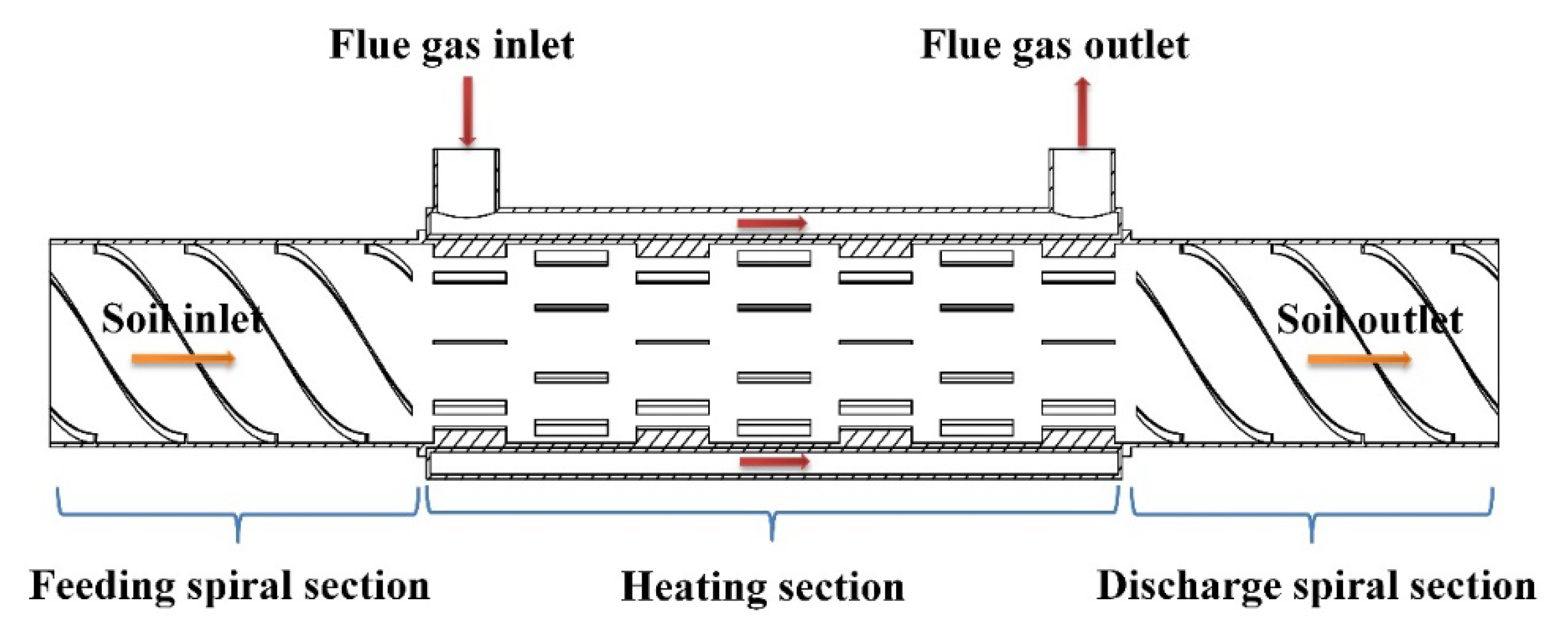
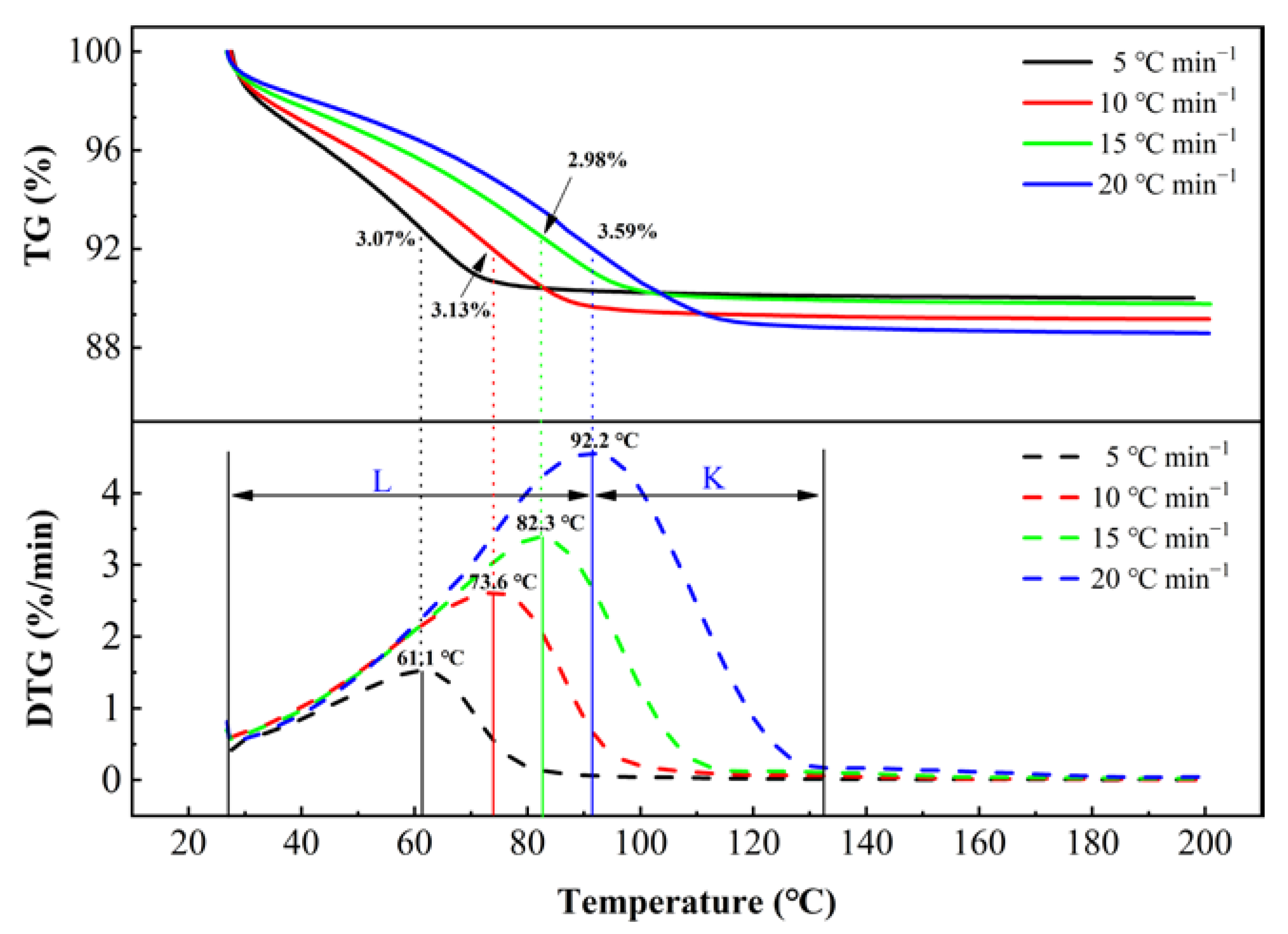
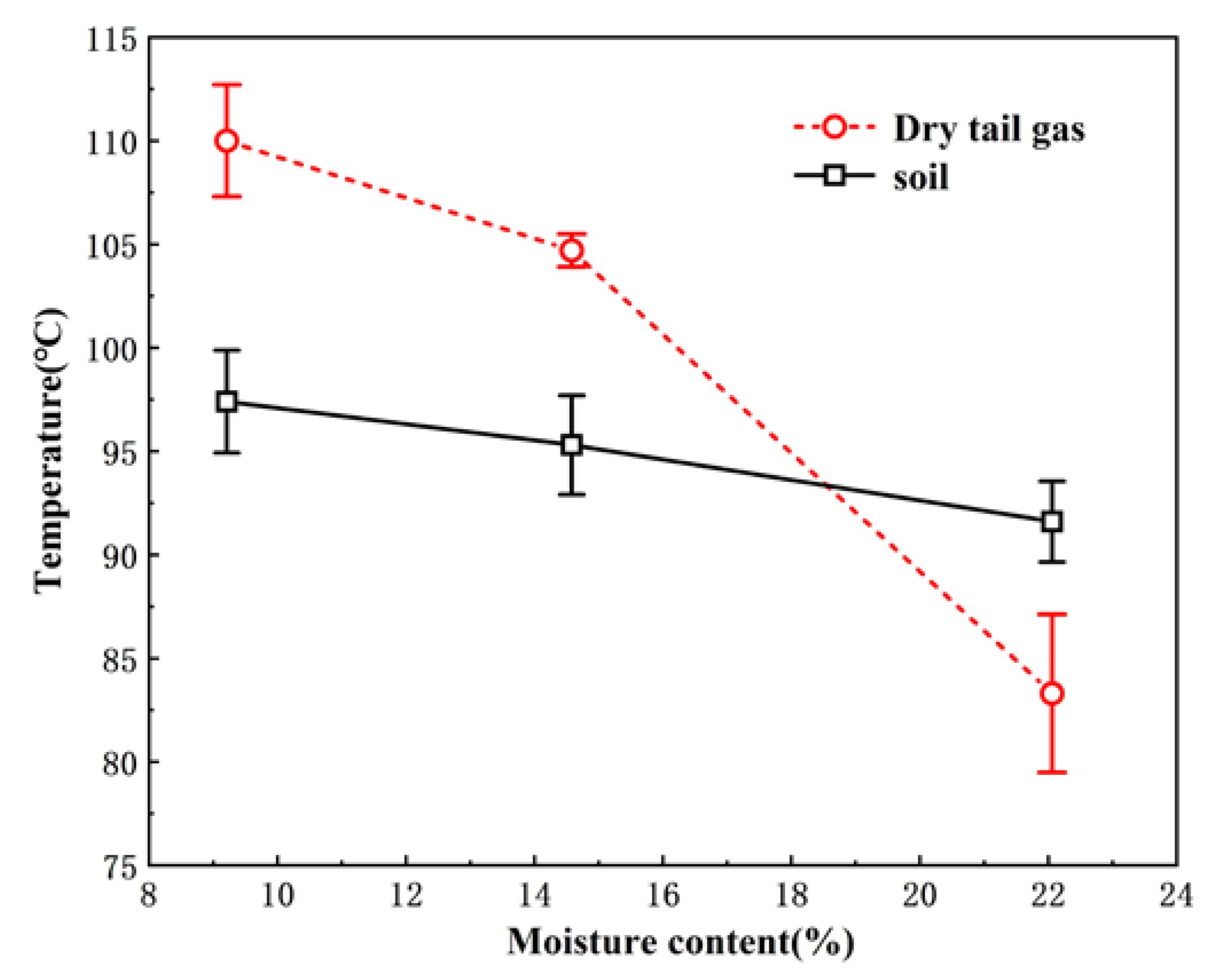
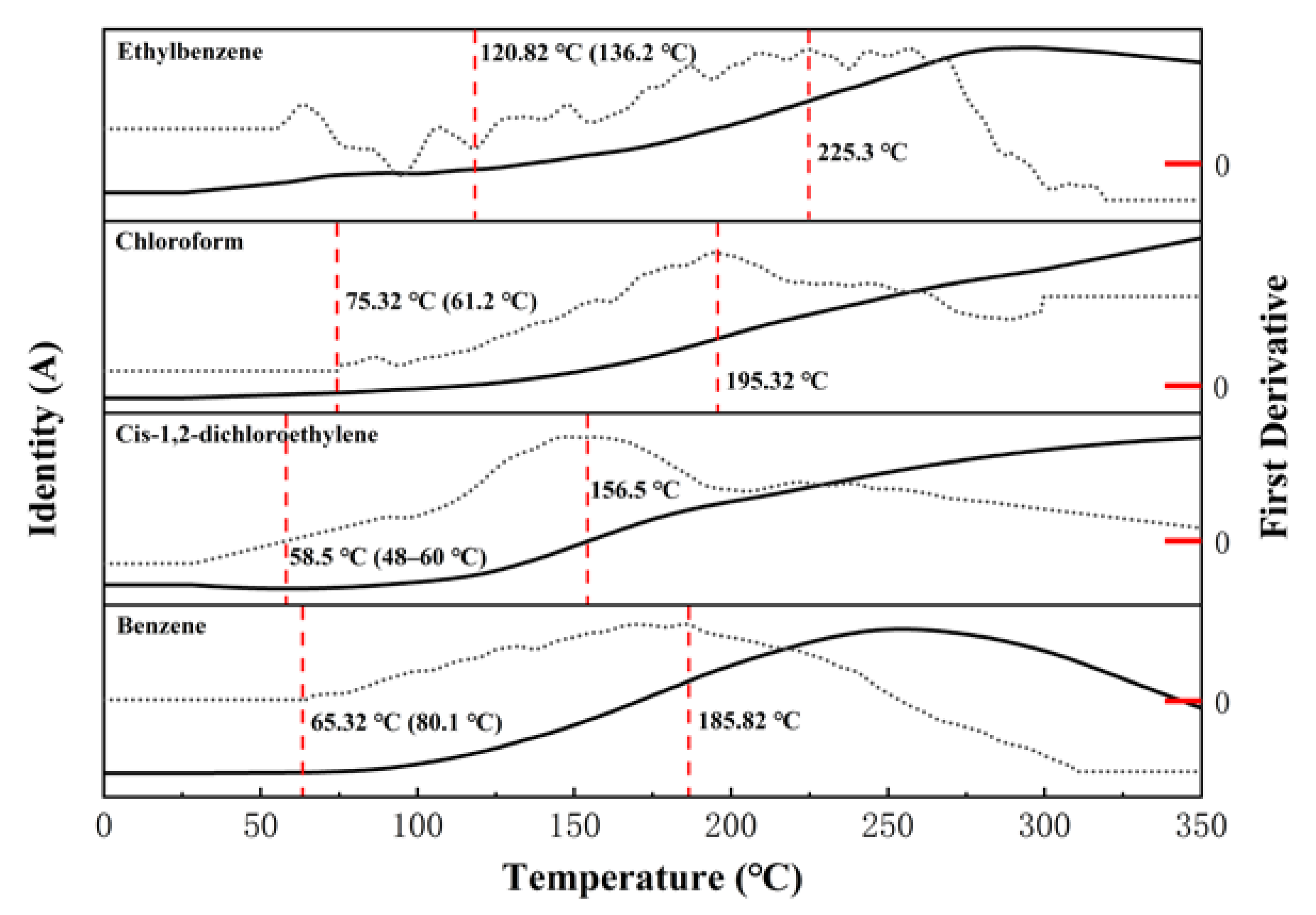
| Pollutant | Concentration (mg kg−1) |
|---|---|
| Dichloromethane | 23.4 |
| Trans-1,2-dichloroethylene | 0.825 |
| Cis-1,2-dichloroethylene | 7.04 |
| Chloroform | 25.3 |
| 1,2-Dichloroethane | 1.1 |
| Benzene | 0.014 |
| Trichloroethylene | 0.088 |
| 1,1,2-Trichloroethane | 0.155 |
| Tetrachloroethylene | 0.173 |
| Ethyl benzene | 0.061 |
| M-xylene & P-xylene | 0.436 |
| O-xylene | 0.218 |
| 1,1,2,2-tetrachloroethane | 0.921 |
| Working Condition | Rotation Speed (rpm) | Moisture Content (%) |
|---|---|---|
| L1 | 1 | 9.21 |
| L2 | 2 | 9.21 |
| L3 | 3 | 9.21 |
| M3 | 3 | 14.58 |
| H3 | 3 | 22.06 |
| Working Condition | T1 | T2 | t | Tr | T3 | w | w1 |
|---|---|---|---|---|---|---|---|
| (°C) | (°C) | (min) | (°C min−1) | (°C) | (%) | (%) | |
| L1 | 10.2 | 105.5 | 15′56′′ | 5.98 | 70.3 | 0.11 | 0.24 |
| L2 | 10.2 | 101.5 | 10′34′′ | 8.63 | 94.6 | 0.14 | 0.36 |
| L3 | 10.2 | 97.4 | 7′22′′ | 11.83 | 110.8 | 0.25 | 0.38 |
| Pollutant | Concentration (mg m−3) |
|---|---|
| Dichloromethane | <0.3 |
| Trans 1,2-dichloroethylene | 0.058 |
| Cis-1,2-dichloroethylene | 1.03 |
| 1,2-Dichloroethane | 0.179 |
| Benzene | 2.23 |
| Ethyl benzene | <0.010 |
| 1,1,2-Trichloroethane | <0.0004 |
| Tetrachloroethylene | 0.001 |
| O-xylene | <0.010 |
| Meta-xylene | <0.010 |
| Paraxylene | <0.010 |
| 1,1,2,2-tetrachloroethane | <0.00007 |
| Volatile organic compounds | 0.139 |
| Working Condition | Moisture Content | Volumetric Heat Transfer Coefficient |
|---|---|---|
| (%) | (W m−3 °C−1) | |
| L3 | 9.21 | 86.56 |
| M3 | 14.58 | 92.53 |
| H3 | 22.06 | 97.46 |
Publisher’s Note: MDPI stays neutral with regard to jurisdictional claims in published maps and institutional affiliations. |
© 2022 by the authors. Licensee MDPI, Basel, Switzerland. This article is an open access article distributed under the terms and conditions of the Creative Commons Attribution (CC BY) license (https://creativecommons.org/licenses/by/4.0/).
Share and Cite
Chai, R.; Wang, J.; Zhan, M.; Yuan, D.; Chi, Z.; Gu, H.; Mao, J. Pre-Drying of Chlorine–Organic-Contaminated Soil in a Rotary Dryer for Energy Efficient Thermal Remediation. Int. J. Environ. Res. Public Health 2022, 19, 16607. https://doi.org/10.3390/ijerph192416607
Chai R, Wang J, Zhan M, Yuan D, Chi Z, Gu H, Mao J. Pre-Drying of Chlorine–Organic-Contaminated Soil in a Rotary Dryer for Energy Efficient Thermal Remediation. International Journal of Environmental Research and Public Health. 2022; 19(24):16607. https://doi.org/10.3390/ijerph192416607
Chicago/Turabian StyleChai, Rui, Jinqing Wang, Mingxiu Zhan, Dingkun Yuan, Zuohe Chi, Hailin Gu, and Jiani Mao. 2022. "Pre-Drying of Chlorine–Organic-Contaminated Soil in a Rotary Dryer for Energy Efficient Thermal Remediation" International Journal of Environmental Research and Public Health 19, no. 24: 16607. https://doi.org/10.3390/ijerph192416607
APA StyleChai, R., Wang, J., Zhan, M., Yuan, D., Chi, Z., Gu, H., & Mao, J. (2022). Pre-Drying of Chlorine–Organic-Contaminated Soil in a Rotary Dryer for Energy Efficient Thermal Remediation. International Journal of Environmental Research and Public Health, 19(24), 16607. https://doi.org/10.3390/ijerph192416607







